I have a wish list of about 30 tropical plants but until I'm able to find them, I'm using some temporary plants to fill up the garden. Yes, "fill 'er up." That's my style of gardening. Let no space go unused. I've already reduced the lawn area a couple of times to accommodate more plants and this garden has only been growing since January 2005.
Tecoma stans, common name Esperanza orYellow Bells is a glorious flowering shrub that grows easily from seed. I pulled off a couple of dried beans from a plant outside a restaurant in town and tossed the seeds in a large empty pot just barely covering them with rice hulls. The seeds inside the inedible beans look as if they have a covering of cellophane.
from a plant outside a restaurant in town and tossed the seeds in a large empty pot just barely covering them with rice hulls. The seeds inside the inedible beans look as if they have a covering of cellophane.
Although it is a common plant in central America, many people here don't even recognize it because the key to a continuous show of flowers is full sun and keeping those beans cut off. I don't know yet if the blooms will continue throughout the rainy season, but they have been blooming since about February with never more than a few days stop. Bees are always buzzing around these flowers.
Esperanza wants to be a tree, but I won't let it. I pinched these plants several times when they were smaller and now that they are larger, I still have to just chop off the woody tops when they get too tall. I've seen one tree about 18 feet tall but the problem with allowing it to become a tree is the height makes it difficult to remove the persistent beans, which stop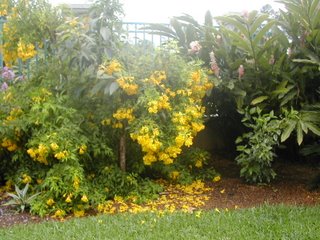 the flowering, plus the dried brown beans are unsightly.
the flowering, plus the dried brown beans are unsightly.
This picture shows one drooping, heavy with rain, but most of the flowers still hanging on. Tecoma Stans is native to Texas. It is hardy in U.S. zones 10-11 but can easily be kept in a pot and brought indoors for the winter. Read more about Esperanza at Texas A&M.
Rhoeo spathacea, common name Moses in a Cradle or Oyster Plant, is a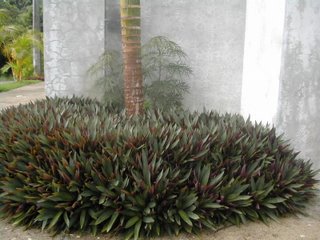 well-behaved edging plant or ground cover. El Jefe bought four 2 inch pots of this a couple of years ago. Now we have at least 800 linear feet of it! It grows only to about 10-12", stays in relatively the same space where it was planted, can take sun or part shade, and provides a wonderful purple contrast in the garden.
well-behaved edging plant or ground cover. El Jefe bought four 2 inch pots of this a couple of years ago. Now we have at least 800 linear feet of it! It grows only to about 10-12", stays in relatively the same space where it was planted, can take sun or part shade, and provides a wonderful purple contrast in the garden.
To propagate, just pinch off about 4 - 6 inches of the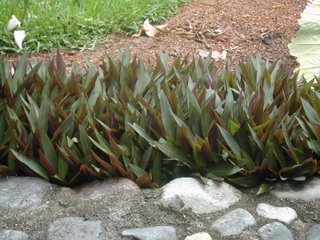 growing point, remove the lower leaves, stick it in the ground, and keep it moist for a few days. It can also be divided by digging up clumps but tends to be leggy when whole parts of the plants are moved elsewhere. It makes a better instant show with the tip cuttings.
growing point, remove the lower leaves, stick it in the ground, and keep it moist for a few days. It can also be divided by digging up clumps but tends to be leggy when whole parts of the plants are moved elsewhere. It makes a better instant show with the tip cuttings.
Rhoeo spathacea is hardy in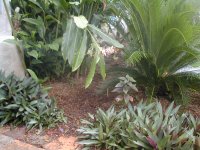 U.S. zones 9 to 11 but can be grown as an annual, pot plant or hanging basket plant just about anywhere.
U.S. zones 9 to 11 but can be grown as an annual, pot plant or hanging basket plant just about anywhere.
It's a tough plant − my chihuahuas like to lay on it for some strange reason − but as you can see from this picture, it won't hold up to continuous rottweiler traffic.
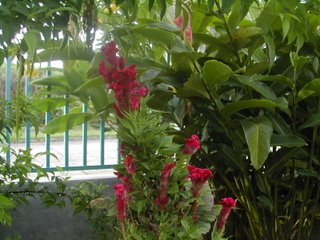 Celosia - Two kinds of celosias reseed prolifically in my yard. They both have purple markings in the foliage and grow to about 5 to 6 feet. The first is C. argentea, v. Cristata (I think). I bought one plant a couple of years ago and have had thousands reseed since then. If I pinch out the growing points when the plant is 18-24 inches tall, it has a more attractive shape and makes several small and medium sized flowers, always this magenta color. If I don't pinch, it makes one huge freaky cabbage-sized head, which of course, the stem can't support.
Celosia - Two kinds of celosias reseed prolifically in my yard. They both have purple markings in the foliage and grow to about 5 to 6 feet. The first is C. argentea, v. Cristata (I think). I bought one plant a couple of years ago and have had thousands reseed since then. If I pinch out the growing points when the plant is 18-24 inches tall, it has a more attractive shape and makes several small and medium sized flowers, always this magenta color. If I don't pinch, it makes one huge freaky cabbage-sized head, which of course, the stem can't support.
The other is C. argentea v. spicata, which has clusters of dark pink spiky flowers similar to C. flamingo feather. I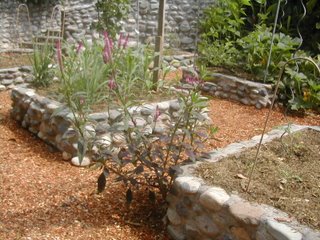 planted this variety from seeds, and like the first, it reseeds prolifically. Germination generally occurs in about 24 hours. I usually cut off the flower/seed heads before composting the spent plants. Bees also love these flowers so if they sprout near the vegetable garden I let them grow there.
planted this variety from seeds, and like the first, it reseeds prolifically. Germination generally occurs in about 24 hours. I usually cut off the flower/seed heads before composting the spent plants. Bees also love these flowers so if they sprout near the vegetable garden I let them grow there.
Both plants have straight, long, stiff stems that break easily in rainstorms or just from the weight of the flowers. A friend of mine is going to try them in Iowa as a screen in front of her compost pile.
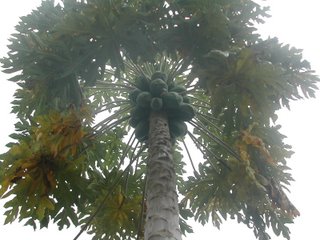 Carica papayas - Our first papaya trees were accidental; they grew out of our compost piles. We had several females and two males which everyone wanted to cut down. I thought the males were needed for pollination but those were the only two males that have ever grown and since then I've discovered that apparently there are enough papaya trees around here that you don't have to have a pollinator in your own yard. That's good because it takes about nine months before the flowers emerge and the female plants can be distinguished from the males. I'm glad I didn't cut them then, though, because the male blossoms are more fragrant. One of the male plants was right outside our upstairs terraza and the fragrance was wonderful, especially at night.
Carica papayas - Our first papaya trees were accidental; they grew out of our compost piles. We had several females and two males which everyone wanted to cut down. I thought the males were needed for pollination but those were the only two males that have ever grown and since then I've discovered that apparently there are enough papaya trees around here that you don't have to have a pollinator in your own yard. That's good because it takes about nine months before the flowers emerge and the female plants can be distinguished from the males. I'm glad I didn't cut them then, though, because the male blossoms are more fragrant. One of the male plants was right outside our upstairs terraza and the fragrance was wonderful, especially at night.
Besides for the fruit, I grow the papayas to provide quick growing height in the garden. Papayas are herbaceous and are easily cut down and removed when they finish producing, usually about 18-24 months for mine. I don't know what variety they are, but they grow to about 14 to 18 feet and have produced papayas of 12 lbs. Some of the trees have produced much smaller fruit of a poorer quality. I just leave those for the birds. Woodpeckers especially like papayas. I always save some seeds from the best papayas and replant five or six trees every 6 months or so.
Taro, common name Elephant Ears - I bought one plant because I like the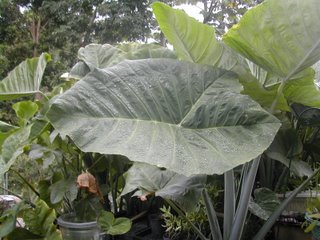 tropical look but now we have them everywhere. They are invasive in drainage ditches and other swampy areas but I didn't know they would be invasive in my well-drained garden, too. When I find more of my wish-list plants, I will be removing most of them. This leaf is 4 feet long by 3 feet wide. We have eaten some of the taro. It is a little "gummy" for my palate, but maybe I just need a good recipe − mine was reminiscent of Elmer's Glue.
tropical look but now we have them everywhere. They are invasive in drainage ditches and other swampy areas but I didn't know they would be invasive in my well-drained garden, too. When I find more of my wish-list plants, I will be removing most of them. This leaf is 4 feet long by 3 feet wide. We have eaten some of the taro. It is a little "gummy" for my palate, but maybe I just need a good recipe − mine was reminiscent of Elmer's Glue.
Colocasia esculenta var. antiquorum 'Illustris' (black taro) is another variety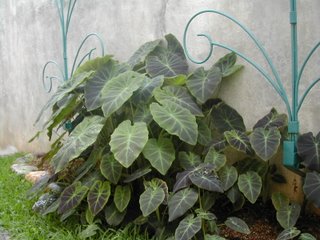 we have. I love black and dark purple plants because they provide such a nice contrast to green. This is smaller than the other taro but even more invasive. I can only recommend it for a pot or some other contained area. It grows by long underground runners that are very delicate and almost impossible to remove completely. A one inch piece of root left in the ground will grow more plants. It grows best in a part shade area. Too much sun and it sunburns and reverts to mostly green.
we have. I love black and dark purple plants because they provide such a nice contrast to green. This is smaller than the other taro but even more invasive. I can only recommend it for a pot or some other contained area. It grows by long underground runners that are very delicate and almost impossible to remove completely. A one inch piece of root left in the ground will grow more plants. It grows best in a part shade area. Too much sun and it sunburns and reverts to mostly green.
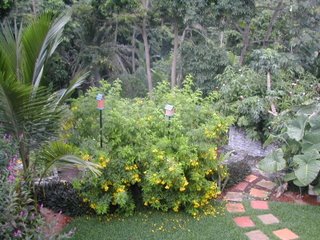 This last picture shows the Celosia spicata on the left, the Yellow Bells in the middle, a very old papaya that is leaning over the wall, the Taro on the right and the Rhoeo lining the wall. This is basically free landscaping: I've never fertilized any of these plants other than mixing in some compost when planting and probably spent less than $5 total on all of them so I'd say they were a pretty good investment. I'll continue growing them in the future, just not so many as we have now.
This last picture shows the Celosia spicata on the left, the Yellow Bells in the middle, a very old papaya that is leaning over the wall, the Taro on the right and the Rhoeo lining the wall. This is basically free landscaping: I've never fertilized any of these plants other than mixing in some compost when planting and probably spent less than $5 total on all of them so I'd say they were a pretty good investment. I'll continue growing them in the future, just not so many as we have now.
Tecoma stans, common name Esperanza orYellow Bells is a glorious flowering shrub that grows easily from seed. I pulled off a couple of dried beans
 from a plant outside a restaurant in town and tossed the seeds in a large empty pot just barely covering them with rice hulls. The seeds inside the inedible beans look as if they have a covering of cellophane.
from a plant outside a restaurant in town and tossed the seeds in a large empty pot just barely covering them with rice hulls. The seeds inside the inedible beans look as if they have a covering of cellophane.Although it is a common plant in central America, many people here don't even recognize it because the key to a continuous show of flowers is full sun and keeping those beans cut off. I don't know yet if the blooms will continue throughout the rainy season, but they have been blooming since about February with never more than a few days stop. Bees are always buzzing around these flowers.
Esperanza wants to be a tree, but I won't let it. I pinched these plants several times when they were smaller and now that they are larger, I still have to just chop off the woody tops when they get too tall. I've seen one tree about 18 feet tall but the problem with allowing it to become a tree is the height makes it difficult to remove the persistent beans, which stop
 the flowering, plus the dried brown beans are unsightly.
the flowering, plus the dried brown beans are unsightly.This picture shows one drooping, heavy with rain, but most of the flowers still hanging on. Tecoma Stans is native to Texas. It is hardy in U.S. zones 10-11 but can easily be kept in a pot and brought indoors for the winter. Read more about Esperanza at Texas A&M.
Rhoeo spathacea, common name Moses in a Cradle or Oyster Plant, is a
 well-behaved edging plant or ground cover. El Jefe bought four 2 inch pots of this a couple of years ago. Now we have at least 800 linear feet of it! It grows only to about 10-12", stays in relatively the same space where it was planted, can take sun or part shade, and provides a wonderful purple contrast in the garden.
well-behaved edging plant or ground cover. El Jefe bought four 2 inch pots of this a couple of years ago. Now we have at least 800 linear feet of it! It grows only to about 10-12", stays in relatively the same space where it was planted, can take sun or part shade, and provides a wonderful purple contrast in the garden.To propagate, just pinch off about 4 - 6 inches of the
 growing point, remove the lower leaves, stick it in the ground, and keep it moist for a few days. It can also be divided by digging up clumps but tends to be leggy when whole parts of the plants are moved elsewhere. It makes a better instant show with the tip cuttings.
growing point, remove the lower leaves, stick it in the ground, and keep it moist for a few days. It can also be divided by digging up clumps but tends to be leggy when whole parts of the plants are moved elsewhere. It makes a better instant show with the tip cuttings.Rhoeo spathacea is hardy in
 U.S. zones 9 to 11 but can be grown as an annual, pot plant or hanging basket plant just about anywhere.
U.S. zones 9 to 11 but can be grown as an annual, pot plant or hanging basket plant just about anywhere.It's a tough plant − my chihuahuas like to lay on it for some strange reason − but as you can see from this picture, it won't hold up to continuous rottweiler traffic.
 Celosia - Two kinds of celosias reseed prolifically in my yard. They both have purple markings in the foliage and grow to about 5 to 6 feet. The first is C. argentea, v. Cristata (I think). I bought one plant a couple of years ago and have had thousands reseed since then. If I pinch out the growing points when the plant is 18-24 inches tall, it has a more attractive shape and makes several small and medium sized flowers, always this magenta color. If I don't pinch, it makes one huge freaky cabbage-sized head, which of course, the stem can't support.
Celosia - Two kinds of celosias reseed prolifically in my yard. They both have purple markings in the foliage and grow to about 5 to 6 feet. The first is C. argentea, v. Cristata (I think). I bought one plant a couple of years ago and have had thousands reseed since then. If I pinch out the growing points when the plant is 18-24 inches tall, it has a more attractive shape and makes several small and medium sized flowers, always this magenta color. If I don't pinch, it makes one huge freaky cabbage-sized head, which of course, the stem can't support.The other is C. argentea v. spicata, which has clusters of dark pink spiky flowers similar to C. flamingo feather. I
 planted this variety from seeds, and like the first, it reseeds prolifically. Germination generally occurs in about 24 hours. I usually cut off the flower/seed heads before composting the spent plants. Bees also love these flowers so if they sprout near the vegetable garden I let them grow there.
planted this variety from seeds, and like the first, it reseeds prolifically. Germination generally occurs in about 24 hours. I usually cut off the flower/seed heads before composting the spent plants. Bees also love these flowers so if they sprout near the vegetable garden I let them grow there.Both plants have straight, long, stiff stems that break easily in rainstorms or just from the weight of the flowers. A friend of mine is going to try them in Iowa as a screen in front of her compost pile.
 Carica papayas - Our first papaya trees were accidental; they grew out of our compost piles. We had several females and two males which everyone wanted to cut down. I thought the males were needed for pollination but those were the only two males that have ever grown and since then I've discovered that apparently there are enough papaya trees around here that you don't have to have a pollinator in your own yard. That's good because it takes about nine months before the flowers emerge and the female plants can be distinguished from the males. I'm glad I didn't cut them then, though, because the male blossoms are more fragrant. One of the male plants was right outside our upstairs terraza and the fragrance was wonderful, especially at night.
Carica papayas - Our first papaya trees were accidental; they grew out of our compost piles. We had several females and two males which everyone wanted to cut down. I thought the males were needed for pollination but those were the only two males that have ever grown and since then I've discovered that apparently there are enough papaya trees around here that you don't have to have a pollinator in your own yard. That's good because it takes about nine months before the flowers emerge and the female plants can be distinguished from the males. I'm glad I didn't cut them then, though, because the male blossoms are more fragrant. One of the male plants was right outside our upstairs terraza and the fragrance was wonderful, especially at night.Besides for the fruit, I grow the papayas to provide quick growing height in the garden. Papayas are herbaceous and are easily cut down and removed when they finish producing, usually about 18-24 months for mine. I don't know what variety they are, but they grow to about 14 to 18 feet and have produced papayas of 12 lbs. Some of the trees have produced much smaller fruit of a poorer quality. I just leave those for the birds. Woodpeckers especially like papayas. I always save some seeds from the best papayas and replant five or six trees every 6 months or so.
Taro, common name Elephant Ears - I bought one plant because I like the
 tropical look but now we have them everywhere. They are invasive in drainage ditches and other swampy areas but I didn't know they would be invasive in my well-drained garden, too. When I find more of my wish-list plants, I will be removing most of them. This leaf is 4 feet long by 3 feet wide. We have eaten some of the taro. It is a little "gummy" for my palate, but maybe I just need a good recipe − mine was reminiscent of Elmer's Glue.
tropical look but now we have them everywhere. They are invasive in drainage ditches and other swampy areas but I didn't know they would be invasive in my well-drained garden, too. When I find more of my wish-list plants, I will be removing most of them. This leaf is 4 feet long by 3 feet wide. We have eaten some of the taro. It is a little "gummy" for my palate, but maybe I just need a good recipe − mine was reminiscent of Elmer's Glue. Colocasia esculenta var. antiquorum 'Illustris' (black taro) is another variety
 we have. I love black and dark purple plants because they provide such a nice contrast to green. This is smaller than the other taro but even more invasive. I can only recommend it for a pot or some other contained area. It grows by long underground runners that are very delicate and almost impossible to remove completely. A one inch piece of root left in the ground will grow more plants. It grows best in a part shade area. Too much sun and it sunburns and reverts to mostly green.
we have. I love black and dark purple plants because they provide such a nice contrast to green. This is smaller than the other taro but even more invasive. I can only recommend it for a pot or some other contained area. It grows by long underground runners that are very delicate and almost impossible to remove completely. A one inch piece of root left in the ground will grow more plants. It grows best in a part shade area. Too much sun and it sunburns and reverts to mostly green. This last picture shows the Celosia spicata on the left, the Yellow Bells in the middle, a very old papaya that is leaning over the wall, the Taro on the right and the Rhoeo lining the wall. This is basically free landscaping: I've never fertilized any of these plants other than mixing in some compost when planting and probably spent less than $5 total on all of them so I'd say they were a pretty good investment. I'll continue growing them in the future, just not so many as we have now.
This last picture shows the Celosia spicata on the left, the Yellow Bells in the middle, a very old papaya that is leaning over the wall, the Taro on the right and the Rhoeo lining the wall. This is basically free landscaping: I've never fertilized any of these plants other than mixing in some compost when planting and probably spent less than $5 total on all of them so I'd say they were a pretty good investment. I'll continue growing them in the future, just not so many as we have now.

 Welcome to my Blogicito —
Welcome to my Blogicito — 







